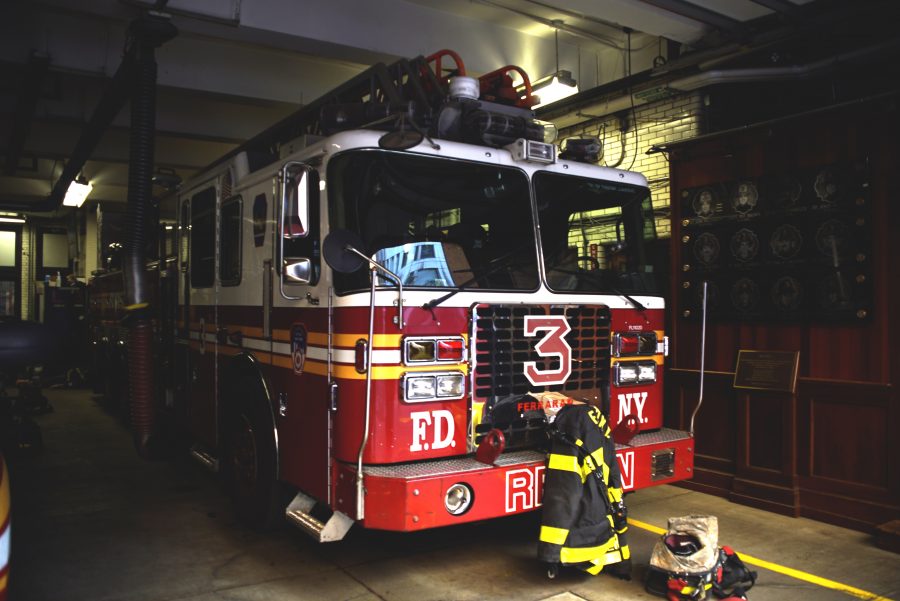It’s hard to know your enemy when your enemy is fire. But with NYU Tandon School of Engineering’s Advanced Learning through Integrated Visual Environments program, firefighters receive potentially life-saving information from scientific studies faster than ever, on top of being able to train in a virtual environment.
ALIVE started in 2008, when New York Fire Captain John Ceriello asked NYU researchers to develop a faster, more efficient way to spread their findings. Cerillo wanted his data concerning wind effects on high-rise fires to reach the 5,000 members of New York City Fire department quickly, as the sooner the information reached them the sooner they could start applying it to real-life fires. NYU researchers began to work on a program in coordination with firefighters from New York, Chicago and Bloomington, Indiana to help Cerillo.
Currently, in Chicago, a new recruit spends their first six months in training. A day of training might involve anything from using thermal image technology to locate a burning microwave, to a discussion of the best approach for a water rescue.
“These are the things we do on a daily basis just to keep our skills sharp,” Jim Foszcz, Battalion Chief in the Chicago Fire Department states, said in a phone interview with WSN.
This is one-way ALIVE has been used by more than 75,000 firefighters in more than 1,000 departments across the United States Firefighters are guided through scenarios and asked questions as they go. The modules give firefighters different scenarios and evaluate their decisions in real time. In each scenario, firefighters are asked to vary their approach to the fire based on factors like wind speed and weather conditions. The program explains why answers are correct or incorrect, then saves the information. This allows training to be a more interactive experience. Studies have shown that with ALIVE, both training and retention improve.
Dr. Prabodh Panindre, a senior scientist and program manager at ALIVE, said the program will improve precision in essential aspects of training.
“I think the real value [of ALIVE] is that as firefighters are going through the tests, all the responses are saved into a database and you can see what firefighters are getting — or not getting — and where to focus the hands-on training,” Panindre said.
ALIVE also claims to prevent accidents by spreading information quickly and cost-effectively. With 70 percent of our nation’s firefighting force being volunteer units, resources to send someone to a conference on new research in fire safety are often lacking, which can lead to firefighters not learning about new procedures. ALIVE ensures that life-saving information can be reached by other firefighters without delay.
Chief Pete Scully, fire captain with CAlFire and a consultant on ALIVE, explained the importance of training and good information, and how these factors can mean life or death for those in the firefighting community.
“If you can’t recognize the potential for a situation to get dangerous, there are safety concerns,” Scully said. “Unfortunately, we lose people every year this way. That’s unacceptable because these things are pretty much predictable. Every time [an accident] happens, take off the gloss and it’s because someone made a mistake.”
In the future, NYU researchers are hoping to expand ALIVE to also help other emergency personnel train more efficiently and prevent avoidable mistakes. According to researchers, these ideas include engaging firefighters in current pressing issues such as shooter-focused modules and cancer research.
“We are realizing through studies recently that you absorb quite a few carcinogens after a fire, and nobody thought about these things before,” Battalion Chief Jim Foszcz told WSN. “We thought you come back from a fire stop, wash your face or whatever, but now we are much more aware, because of the higher rates of cancer that firefighters have.”
ALIVE, through its variety of applications, gives back to firefighters who have sacrificed much for their communities.
“I see the passion, [I see] that they want to save lives. Now we also want to save their lives,” Dr. Panindre told WSN.
Email Sarah John at [email protected].


























































































































































